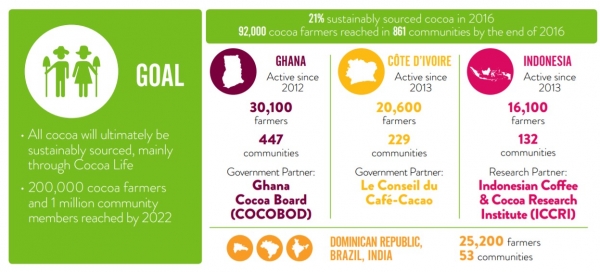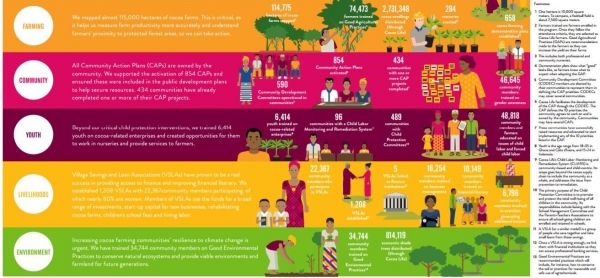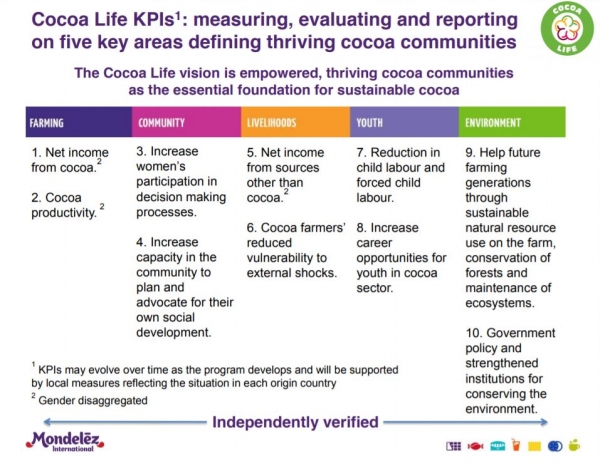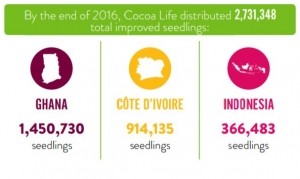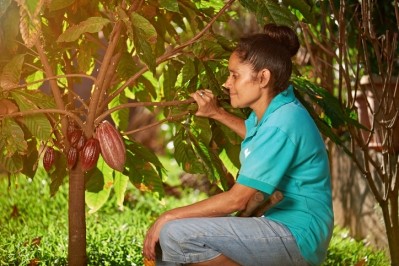Mondelēz scales up Cocoa Life, but total volumes sourced sustainably flat at 21%

In a recently published Cocoa Life progress report, the company said it sourced 21% of its cocoa supply sustainably – either via Cocoa Life or a third party certification – by the end of 2016.
This was the same proportion as in 2015, although the Cadbury maker’s Cocoa Life program has since reached 15,300 more cocoa farmers.
‘We first need to expand the numbers…’
Jane Corcoran, corporate external communications at Mondelēz International, told ConfectioneryNews: “In order to increase our sustainably-sourced volumes, we first need to expand the numbers of farmers participating in the program, which was our focus last year.
“In fact, we grew Cocoa Life substantially, driven by the sizable increase in the number of farmers and communities that we successfully brought into the program.”
Cocoa Life reached 92,000 cocoa farmers by the end of 2016. It aims to reach 200,000 cocoa farmers and 1m community members by 2022.
Scaling up to 100%
The company’s latest progress report said: “The ultimate goal is to source all cocoa sustainably, mainly via Cocoa Life.”
Caobisco (European confectionery association) president Alessandro Cagli, also public affairs director at Ferrero, in June urged companies to commit to deadlines to source 100% sustainable cocoa and palm oil.
Mondelēz’s Corcoran said: “We have not set a deadline for achieving 100% sustainably-sourced cocoa.
“Our holistic approach is meant to create lasting, transformative change in the cocoa supply chain, which is constrained by a complex range of technical, environmental and socio-economic challenges.
“Building solutions will take time. Therefore, we don’t think setting deadlines for achieving 100% sustainable cocoa is realistic.”
‘Transitioning out of certified…’
Mondelēz declined to specify the percentage of sustainable volumes coming via its own program Cocoa Life and the amount coming from third party certification such as UTZ and Fairtrade.
But Corcoran said:“We’re progressively bringing Cocoa Life to our brands and transitioning out of certified volume.”
The company in November last year named Fairtrade as its global implementing partner for Cocoa Life, marking a new way in which certification programs work with chocolate brands. See HERE for more details.
Cocoa Life: 10-year, $450m program
The Milka and Oreo brand owner launched its 10-year, $450m Cocoa Life program in 2012. It built on the Cadbury Cocoa Partnership, founded in 2008 in Ghana.
Cocoa Life is active mainly in Ghana, Côte D’Ivoire and Indonesia with operations also in Dominican Republic, Brazil and India.
The program works with farmers and cocoa-growing communities to enhance five focus areas:
- Farming (e.g. mapping, good agricultural practices training)
- Community (e.g. gender awareness training)
- Livelihoods ( e.g. setting up Village Savings and Loan Associations)
- Youth (e.g. establishing child labor monitoring and remediation systems)
- Environment (e.g. training and shade tree distribution)
Research agency Ipsos annually assesses Cocoa Life’s outcomes against 10 global key performance indicators (KPIs). (See also image below).
Certification body FLOCERT verifies the flow of cocoa from Cocoa Life communities into Mondelēz’s supply chain and the benefits received by farmers.
Farm mapping and child labor prevention
Mondelēz said in its progress report it has acted on advice by human rights consultancy Embode to strengthen child protection by implementing community-based Child Labor Monitoring & Remediation Systems (CLMRS).
Cocoa Life had a CLMRS in 96 communities by the end of 2016, out of the 861 communities it covers.
Mondelēz also mapped almost 115,000 hectares of cocoa farms by the end of last year.
“This is critical as it helps us understand if farmers’ productivity improves and gives us information on whether farmers are encroaching on protected forest areas, so that we can take action accordingly,” said Cathy Pieters, program director of Cocoa Life.
Mondelēz has launched a publically available Interactive Cocoa Farm Map that shows the location and size of its Cocoa Life farms, as well as the number of farmers in the program.
Cocoa seedling expansion
The company said one of its most successful Cocoa Life interventions in 2016 was expanding its seedling program.
The chocolate maker has distributed 2,731,348 cocoa seedlings – developed at professional nurseries - since Cocoa Life’s launch to the end of 2016. Last year it expanded the seedlings program beyond Ghana to Côte d’Ivoire and Indonesia.
What about income and yields?
The latest Cocoa Life progress report does not contain data on yield and income changes for farmers in the program.
Mondelēz expects to publish income and yield data for its top three Cocoa Life origins - Côte d’Ivoire, Ghana and Indonesia – later this year.
Its previous progress report said farmer income increased 49% more and cocoa yield increased 37% more in Ghanaian Cocoa Life communities than in communities outside the program.
